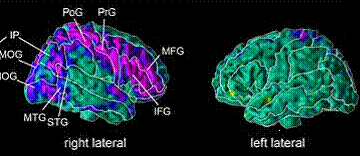Published: March 23, 2009

(At left): this MRI image depicts where a person at high risk for depression has lost a significant portion of brain tissue in the right lateral cortex of the brain’s right hemisphere (color-coded with purple and blue colors indicating loss of brain tissue), compared to the MRI image (at right) of the left lateral brain which shows no loss of brain matter. Average loss of brain tissue among people at high risk for depression was 30 percent.
Findings from one of the largest-ever imaging studies of depression indicate that a structural difference in the brain – a thinning of the right hemisphere – appears to be linked to a higher risk for depression, according to new research at Columbia University Medical Center and the New York State Psychiatric Institute. [continue reading…]
Published: March 10, 2009
Have you ever witnessed a sudden death? It sort of brings everything into perspective, doesn’t it? Watch this touching video by Therese J. Bourchard who talks about here experience.
Source: Beyond Blue

Image:Creative Commons
Life is hard for the children of a parent suffering from depression. Children take on an enormous amount of responsibility for the ill parent and for other family members. It is therefore important for the health services to be aware of this and have support functions in place for the whole family, and not just for the person who is ill. This is the conclusion of a thesis from the Sahlgrenska Academy, University of Gothenburg, Sweden.
[continue reading…]
Quality of life for aging boomers a public imperative, says gerontologist

Image credit: iStockphoto
 Gerontologist John Krout has spent his professional life studying the elderly and aging. He is known for his work on quality of life for the elderly (including the impact of engagement and creativity), livable communities and aging, senior centers, retirement facilities, intergenerational partnerships, and rural elderly. Now as boomers come of age, he turns his attention to creativity and aging, and the changing perspectives of aging. [continue reading…]



